Vertical Garden Construction Market Research: 2032
The Global Vertical Garden Construction Market Size was valued at $1081.7 million in 2022, and is projected to reach $2468.3 million by 2032, growing at a CAGR of 8.6% from 2023 to 2032. In a vertical garden, plants are planted in pots, or other hydroponic growing media, and are allowed to grow vertically on the wall or on other support structures. These are especially useful in urban settings where space is at a premium, and having a conventional horizontal garden would be expensive. Vertical gardens can be planted inside or outside the building and help in enhancing the appearance of the building’s interior as well as exterior. It also helps in reducing the carbon footprint of the building, as the plants absorb CO2 from the atmosphere.
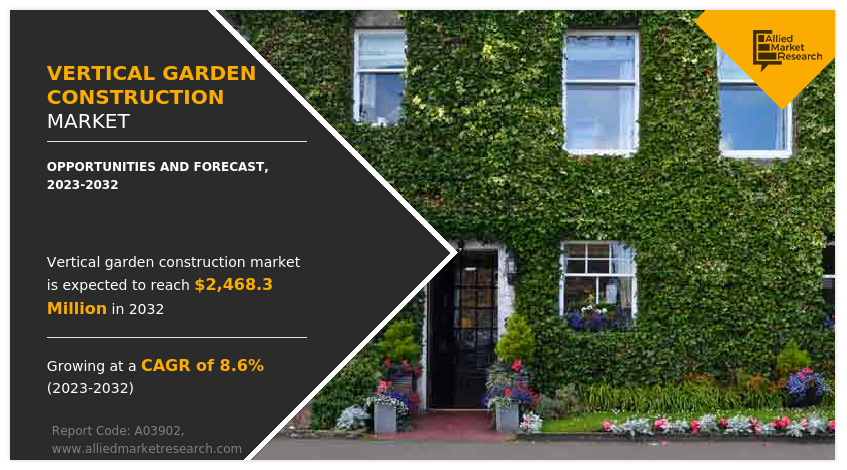
Market Dynamics
The global population is growing at a rapid pace, and therefore, the demand for buildings and other infrastructure is increasing. To make space, in order to build these structures, builders have to cut plants, and trees and disturb the delicate balance between flora and fauna. However, with the growing awareness regarding how these human activities are negatively impacting the earth’s sensitive environment, people across the world have begun planting plants and trees, and demand for green gardens in building complexes has also increased.
With the acceptance of living with nature and having a sustainable lifestyle, the demand for plants and vegetation in homes, offices, hospitals, shopping malls, and others, is increasing at a greater pace. Looking at the growing popularity, architects and engineers are making gardens a part of their designs. However, the fact that land is expensive and is required to construct buildings and other structures for the rapidly growing population cannot be overlooked, and gardens are therefore considered a primary priority.
Thus, as a solution, architects are now designing buildings with vertical gardens, where the plants are grown on a vertical structure that does not take up extra floor or land area. Vertical gardens can be located inside the building on a wall or on a freestanding structure. For the exterior application, vertical gardens are allowed to grow on the façade walls of the buildings.
Moreover, the building sector is responsible for more than 35% of the global CO2 emissions, and private and public entities are therefore working tirelessly to reduce their emissions by restructuring the building sector to build sustainable buildings. For instance, the government of Germany has introduced various laws, policies, and regulations, for the construction and conversion of all building stock to carbon-neutral buildings by 2050. Thus, building developers adopt vertical gardens on the exterior of the building to make it more energy-efficient, as the extra layer of plants over the exterior wall work as insulation, which prevents the interior of the building from heating up. Wall surface temperatures in a temperate zone can be decreased by up to 12°C and ambient temperatures (up to 2m away) by as much as 4°C. A single layer of leaves on a wall can reduce solar radiation by up to 37% and five layers can do the same, reducing it by up to 86%. This eventually reduces 20% of electricity consumption by the air conditioning system. This greatly helps in reducing the carbon footprint of the building. In addition, a vertical garden façade on a building also helps in enhancing its exterior appearance. Such factors positively affects the vertical garden construction market outlook.
However, maintaining a vertical garden, especially the ones that are used for enhancing the façade of the buildings is expensive as it requires skilled workers and specialized equipment, this is anticipated to restrain the vertical garden construction market growth.
Moreover, technological and other developments in the vertical garden construction industry are expected to provide lucrative opportunities for players that operate in the vertical garden construction market. For example, two companies; Rastegar Property Company and a green wall manufacturer named Zauben have collaborated to make technologically advanced vertical garden for a building in New York. The garden will have sensors to monitor soil health and other aspects of the garden to maintain it better at a relatively lower cost.
The demand for vertical garden constructions decreased in 2020, owing to reduced construction activities due to lockdowns imposed by the government of many countries. The COVID-19 pandemic led to the shutdown of the construction and home renovation industry across the world, leading to a halt in demand for vertical garden constructions. This hampered the growth of the vertical garden construction market significantly during the pandemic. The major demand for vertical garden constructions was previously noticed from major countries, including China, the U.S., Germany, Italy, and France, Canada, and other countries having high disposable income. These countries were negatively affected by the spread of coronavirus, thereby halting demand for vertical garden constructions.
However, owing to the introduction of various vaccines, the severity of the COVID-19 pandemic reduced significantly. This has led to the full-fledged reopening of businesses involved in the vertical garden construction market and led to increased activities in the construction sector. Furthermore, it has been more than two and a half years since the outbreak of this pandemic, and many companies have already shown notable signs of recovery. Contrarily, during the beginning of 2023, the number of COVID-19 cases surged again, especially in China, which had an unfavorable impact on the vertical garden construction market for a short duration.
Thus, businesses involved in manufacturing and sales of vertical garden constructions must focus on protecting their workforce, operations, and supply chains to respond to any looming threat of COVID-19. For instance, as of April 2023, COVID-19 cases are rising in India. In addition to COVID-19, another global event; worldwide inflation, driven by Ukraine-Russia war has also negatively affected the construction and mining sector.
Segmental Overview
The vertical garden construction market is segmented on the basis of type, garden type, application, and region. By type, the market is bifurcated into indoor vertical garden wall, and outdoor vertical garden wall. Depending upon garden type, the market is categorized into green wall vertical garden, green façades vertical garden, freestanding vertical garden, and others. On the basis of application, it is divided into residential and commercial. Region wise, it is analyzed across North America (U.S., Canada, and Mexico), Europe (Germany, France, Italy, UK, and rest of Europe), Asia-Pacific (China, India, Japan, South Korea, and rest of Asia-Pacific), and LAMEA (Latin America, Middle East, and Africa).
By Type:
The vertical garden construction market is divided into indoor vertical garden wall, and outdoor vertical garden wall. In 2022, the outdoor vertical garden wall segment dominated the vertical garden construction market, in terms of revenue, and the same segment is expected to grow with a higher CAGR during the forecast period. This is attributed to increasing use of vertical gardens as building façade over large buildings. In addition, outdoor vertical garden walls also help in reducing the temperature of the building by shielding the exterior wall from sun radiation. In addition to this, having plants outside can reduce the risk of plants death owing to lack of sunlight. In addition, the indoor vertical garden wall is also popular in hotels, office buildings, hospitals, and other such places.
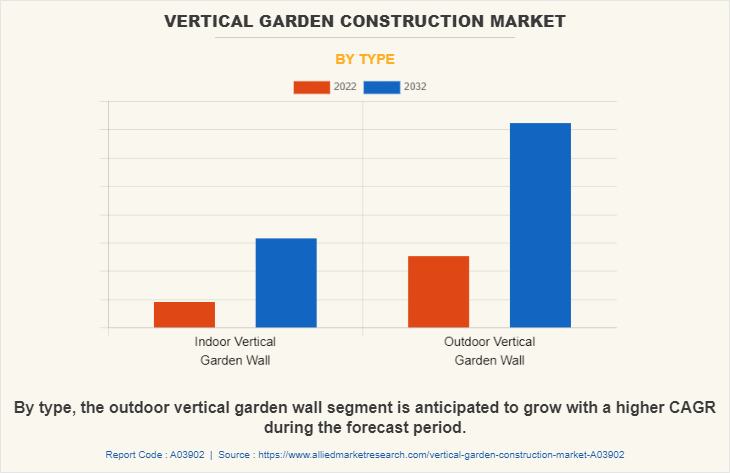
By Garden Type:
The vertical garden construction market is divided into green wall vertical garden, green façades vertical garden, freestanding vertical garden, and others. In 2022, the green wall vertical garden segment accounted for a larger vertical garden construction market share, in terms of revenue, and the green façades vertical garden segment is expected to grow with a higher CAGR during the forecast period. To make the commercial building livelier and create more appealing spaces that would otherwise seem dull, green wall vertical gardens are typically put in commercial buildings at receptions, corridors, waiting rooms, hotel rooms, and other locations. Therefore, it is projected that expansion in the commercial building industry will benefit this sector. Moreover, the green facade vertical gardens improve a building's appearance by covering it with lush and colorful flora. The resulting green layer works as an insulation, preventing direct sunlight from heating the walls and keeping the structure's interior cool.
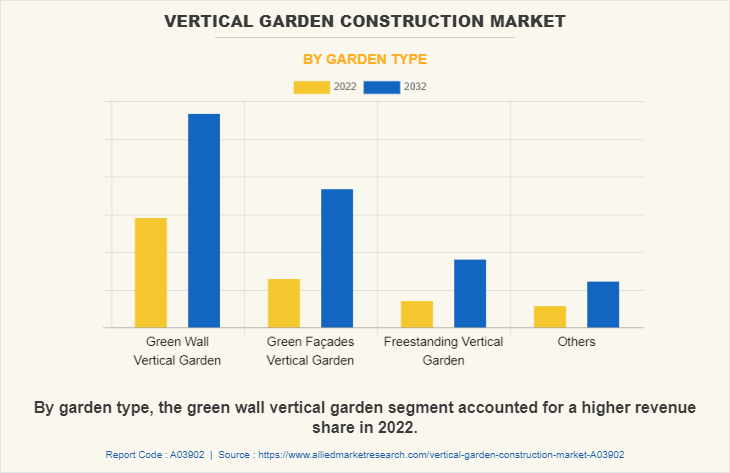
By Application:
The vertical garden construction market is divided between residential and commercial. The commercial segment accounted for a higher market share in 2022. However, the residential segment is anticipated to register a higher growth rate throughout the forecast period. It is expected that the number of commercial buildings will increase significantly in future years.
This is due to increased opportunities in metropolitan regions, improved schools, and other things that provide a better quality of life. Moreover, the residential segment is anticipated to grow owing to the increasing population and reducing the cost of vertical gardens that make them more affordable to the common man.
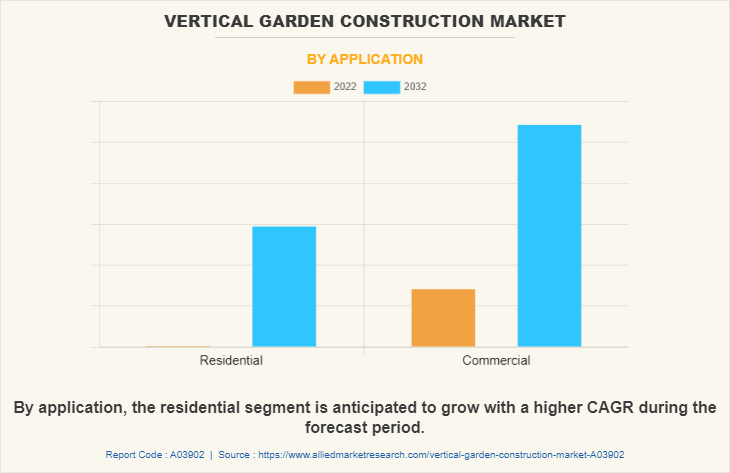
By Region:
Asia-Pacific had the highest market share in 2022 and is expected to maintain its dominance throughout the projected period. This expansion is attributable to rapid economic growth, and population growth, in countries such as China, India, Vietnam, and Indonesia. Furthermore, Asia-Pacific is expected to grow at the highest CAGR throughout the projected period, owing to rapid urban population expansion. Furthermore, countries such as Singapore, Indonesia, Vietnam, Philippines, Mauritius, and other major tourist destinations in the region are also adopting vertical gardens to make their building look better and attract more tourists.
For instance, in April 2021, PLP announced their design for a lavish residential skyscraper in Singapore that would have a lush vertical garden made from the local flora. The biophilic design, which combines indoor and outdoor living areas, attempts to rethink urban life by promoting health and happiness.
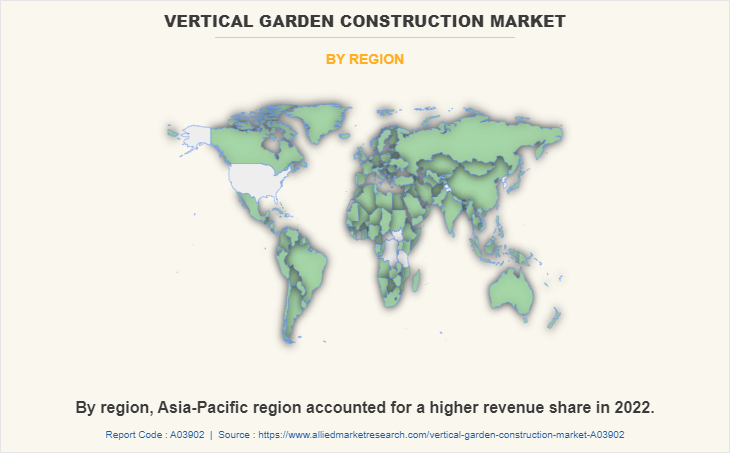
Competition Analysis
Competitive analysis and profiles of the major players in the vertical garden construction market are provided in the report. Major companies in the report include, ANS Group Global Ltd., Atlantis Corporation Australia Pty Ltd, Biotecture Limited, Elmich Pte Ltd, Four Leaf Landscape and Civiltech Pvt Ltd., Fytogreen Australia, LiveWall, LLC, PAISAJISMO URBANO, Sempergreen BV, and ZTC International Landscape Solutions (P) Ltd. Major players to remain competitive adopt development strategies such as acquisition, and others. For instance, in February 2022, Mitie Group plc acquired Biotecture Limited which is a leading manufacturer of living walls for both interior and exterior urban landscapes.
Key Benefits for Stakeholders
- The report provides an extensive analysis of the current and emerging vertical garden construction market trends and dynamics.
- In-depth vertical garden construction market analysis is conducted by constructing market estimations for key market segments between 2022 and 2032.
- Extensive analysis of the vertical garden construction market is conducted by following key product positioning and monitoring of top competitors within the market framework.
- A comprehensive analysis of all the regions is provided to determine the prevailing opportunities.
- The vertical garden construction market forecast analysis from 2023 to 2032 is included in the report.
- The key players within the vertical garden construction market are profiled in this report and their strategies are analyzed thoroughly, which helps understand the competitive outlook of the vertical garden construction industry.
Vertical Garden Construction Market Report Highlights
| Aspects | Details |
| Market Size By 2032 | USD 2468.3 million |
| Growth Rate | CAGR of 8.6% |
| Forecast period | 2022 - 2032 |
| Report Pages | 259 |
| By Application |
|
| By Type |
|
| By Garden Type |
|
| By Region |
|
| Key Market Players | Mitie Group plc (Biotecture Limited), ZTC International Landscape Solutions (P) Ltd., Four Leaf Landscape and Civiltech Pvt Ltd., Fytogreen Pty Ltd., SemperGreenwall, Paisajismo Urbano, Atlantis Corporation Australia Pty Ltd, LiveWall, LLC, Elmich Pte Ltd, ANS Group Global Ltd. |
Analyst Review
According to the insights of the top-level CXOs, the vertical garden construction market has witnessed significant growth in the past few years owing to Increasing demand for energy-efficient buildings, and growing popularity of aesthetically appealing urban structures, and the growth in building renovation and improvement activities. Moreover, the rise in construction of new buildings, attributed to rising population and urbanization is also anticipated to open new opportunities for the vertical garden construction market.
In premium buildings, such as buildings used for commercial purposes, or high-end homes often opt for green wall vertical gardens at the entrance, or in lobbies where people often sit. Furthermore, interior vertical gardens help in improving indoor air quality by up to 85.8% according to NASA's Clean Air Study. Moreover, it also helps in improving the mood of residents; thereby, increasing productivity by about 15%, as per research conducted by Texas A&M University on how plants and vegetation help improve creativity of the people. Thus, giants such as Google and Apple are adopting interior vertical gardens at their workplaces to boost the productivity of the workers. These are among the many benefits of vertical gardens.
The CXOs further added that façade vertical gardens are difficult and expensive to maintain and require professional services which may have negative impacts on the market. However, various incorporation of technology into vertical gardens are anticipated to provide lucrative growth opportunities to the key market players.
Increasing demand for energy-efficient buildings, growing popularity of aesthetically appealing urban structures, growth in building renovation and improvement activities, are few of the upcoming trends of Vertical Garden Construction Market in the world.
Vertical gardens are typically installed indoor and outdoor of residential and commercial buildings.
Asia-Pacific is the largest regional market for Vertical Garden Construction.
The global vertical garden construction market was valued at $10,81,723.7 thousand in 2022.
Major companies included in the report are, ANS Group Global Ltd., Atlantis Corporation Australia Pty Ltd, Biotecture Limited, Elmich Pte Ltd, Four Leaf Landscape and Civiltech Pvt Ltd., Fytogreen Australia, LiveWall, LLC, PAISAJISMO URBANO, Sempergreen BV, and ZTC International Landscape Solutions (P) Ltd.
The company profile has been selected on factors such as geographical presence, market dominance (in terms of revenue and volume sales), various strategies and recent developments.
The global vertical garden construction market is projected to reach $24,68,326.9 thousand by 2032, registering a CAGR of 8.6% from 2023 to 2032.
Depending on application, commercial segment accounted for a larger Vertical Garden Construction Market share in 2022?
Loading Table Of Content...
Loading Research Methodology...



